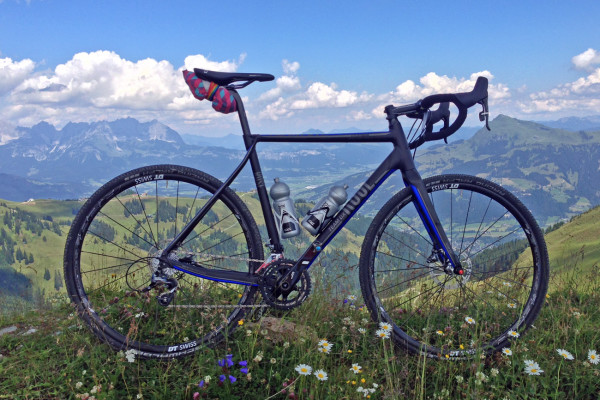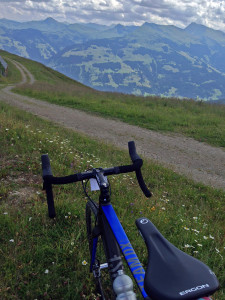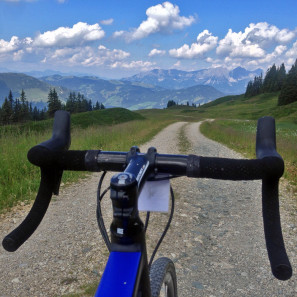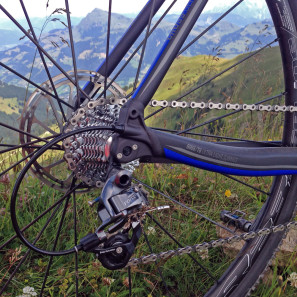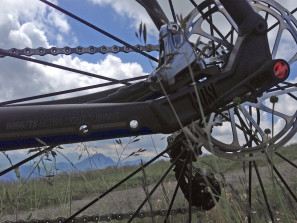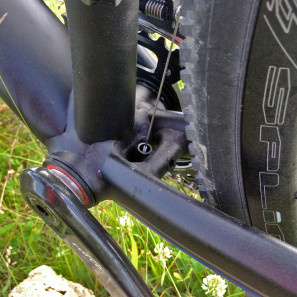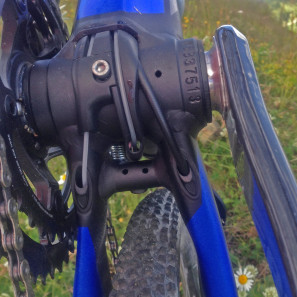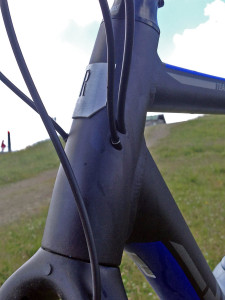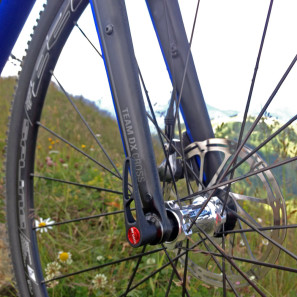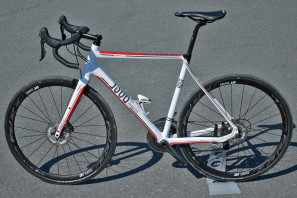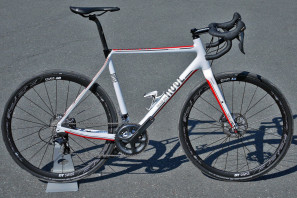Rose bikes introduced an all new bike in their cyclocross family last week called the Team DX Cross. We had a chance to point the bike up and over some Alpine dirt and gravel roads, to go where only ski lifts should go, to find some wet mud along the way, and to bomb back down to the valley again. We’re not so sure about the team moniker for a cross bike, as it is still aluminum, not exceptionally lightweight, and has a host of multi-purpose features, but one of their pro team mountain bikers is getting some cross training in racing it, so maybe.
Read on for the full details on the new bike and to see where we feel it might best find its place…
The Team DX Cross really is a mixed-surface bike with randonneur in its heart (DX gets added on to all of their road disc brake bikes.) The bike has eyelets on frame and fork to run fenders and will clear 42mm tires with the mud guards installed. It also has an all-carbon tapered-steerer fork with low-rider rack mounts for true touring (with mounts accessible on both the inside and outside of the fork legs for more mounting flexibility.)
The 6066 T6 aluminum Team DX Cross gets a number of different hydroformed tubing shapes, machined dropouts, and an asymmetric rear end. Braking both front and rear use the new flat mount disc brake standard. Oddly enough for a bike with Team in the name, it gets an integrated kickstand (yep!) plate next to the rear brake. While it surely doesn’t add much to the overall weight of the frame, it does make it clear that Rose doesn’t really take the idea of a cyclocross race bike too seriously at the moment.
The frame gets a 10x135mm thru-axle. This shorter axle standard runs into problems we’ve seen before, where there is a slot on the non-driveside to drop the wheel in place at the rotor, but on the driveside there is nothing to align the wheel in the frame. When I had to change a flat it took a bit of wiggling the wheel back and forth while trying to line up the driveside hub and axle, while at the same time spinning the DT axle in from the other side. It wasn’t a huge pain, as it is something I’ve had to get used to on other bikes, but it becomes frustrating when mud is involved or if you are in a hurry (not to mention that it opens up the possibility to bend a rotor if you say dropped the bike before the axle catches the threads on the driveside.)
Routing is all internal through the downtube, which results in an awkward guide at the bottom bracket. It wasn’t an issue on my (mostly) dry test, but even then there was mud stuck into that little tube holding the front derailleur cable (in front of the chainstay brace) after my muddier sections. And with that chainstay brace there and limited clearance around the derailleur wire, any sustained mud riding will quickly turn that into a shelf to build up with mud.
From a functionality perspective, the large opening at the bottom of the downtube and the generous openings in the chainstays should make routing cables easy enough. And the inclusion of true fender mounts will make the bike a bit more versatile. From a cyclocross perspective, I think the bike would need a sealed housing solution to survive a season, and even then I would look at some homegrown solution to sealing those holes.
Like a lot of Roses, the Team DX Cross gets a fairly long headtube (with a nice simple head badge.) Our 57cm long seattube bike had a 18.5cm long headtube, and with just 39cm of reach made for a very upright riding position. That long tapered headtube leaves plenty of real estate for all of the cables to enter from the front and go into the downtube.
The new fork for the bike is worth a bit more of a mention. All carbon with a 1.125-1.5″ steerer and a 15x100mm thru-axle, Rose designed it just for this bike, but it kind of is a shame that it won’t likely be available separately. With internal brake line routing in the left leg and even internal wiring routing for a hub dynamo in the right leg, plus the aforementioned low-rider rack and fender mounts, it would make an excellent touring fork. And while the frame seemed to ride fairly stiffly on the gravel washboards and rougher sections of trail, the fork seemed more happy to eat up road and trail chatter. The only one of Rose’s forks that is currently offered on its own is a 26″ CroMo though, so don’t hold your breath. Maybe it will at least make it onto some more randonneur builds.
Speaking of other builds, while Rose calls it a team cross bike, they also had a Team DX Cross AR with AR for All-Road. Outfitted with some fat 32mm Schwalbe Durano slicks it was ready for any road surface you could throw at it. The bike gets a 27.2mm seatpost to try to help soak up the bumps and is clamped with the low-profile integrated seatclamp adapted form their aluminum road line. Overall frame weight is claimed to be 1400g for a medium frame and 460g for the new fork, making the frame a shade lighter than the Pro DX Cross that preceded it, with at least 100g or so off of the fork.
Geometry wise, our test bike had a 71.5°/74° head/seat angles and a 1043mm wheelbase, which are decent racy angles, but a little long overall for a M/L sized bike. We were hoping from the time we saw Team and Cross in the name, that this bike was going to offer the great value and ridability that their Pro SL does on the road, with maybe some more weight savings and smoother ride than the current aluminum Pro DX Cross. While the frame certainly climbed steep hills and dirt road switchbacks well, when it came to rough stuff and twisty descents it felt like it was just bouncing around. The DT Swiss R23 wheels on the bike are plenty stiff and have a relatively narrow inner width that certainly didn’t do the bike any favors, but ultimately the frame seemed to be holding me back when the riding got tight. The smooth feel of the fork did well in keeping the bike comfortable, and did keep handling quick and in control at all times. But in the end, all the braze-ons should have been a good clue that this bike really wants to go out on tour, and will feel a bit out of place racing over barriers and through twisty, muddy winter fields.
As with all Rose bikes, it will be easy to personalize the Team DX Cross when it is available later this year with your choice of 46/36 cross gearing or a road compact 50/34, and either cross tires or some varieties of road slicks. In addition to the AR configuration, it is likely that a Randonneur build will also be preconfigured with racks, fenders, and lights. The bike will be available in 8 sizes with seattube/toptube lengths ranging from 46/51 to 61/59.
